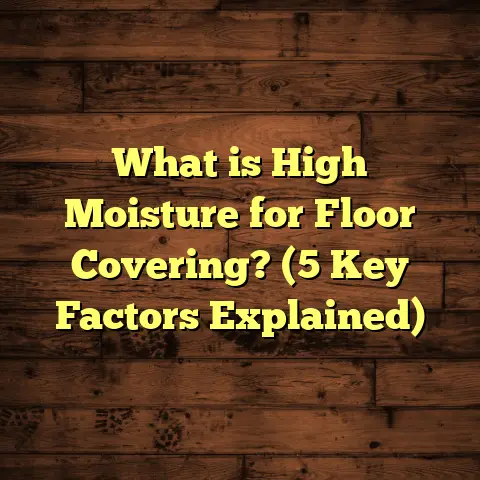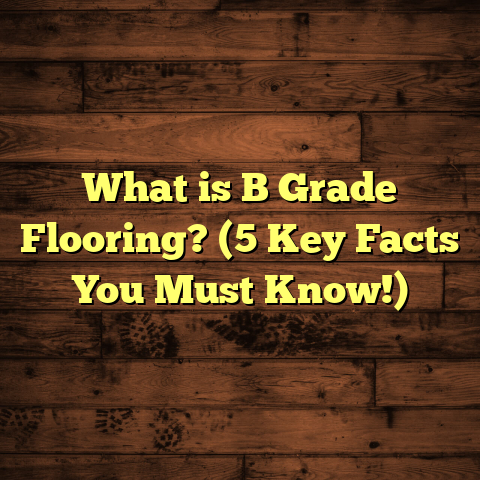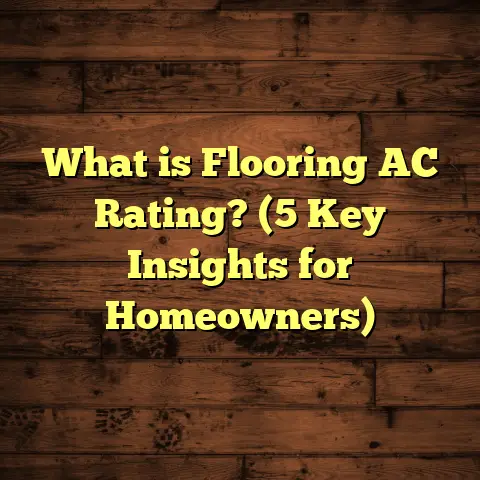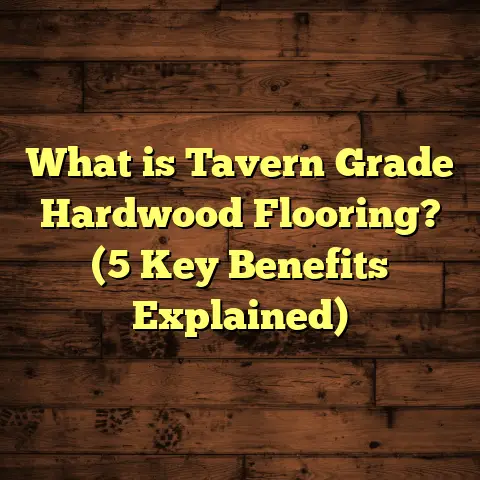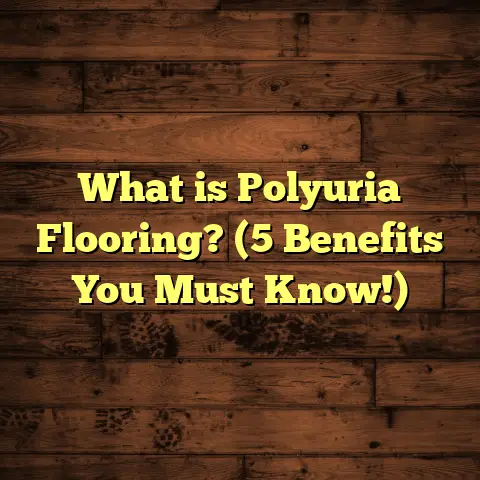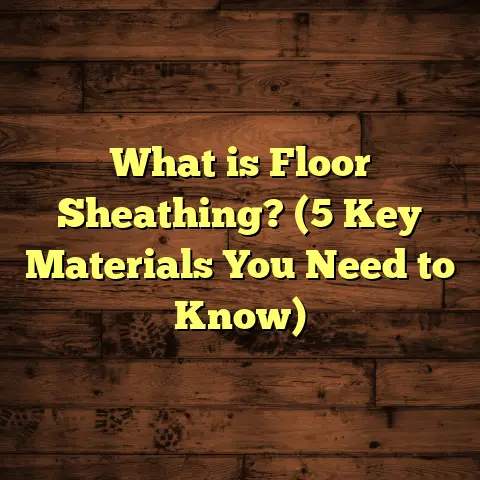What is LVP Plank Flooring? (5 Reasons It’s a Game Changer)
I used to struggle a lot with choosing the right flooring for my home and my clients’ projects. Flooring isn’t just about looks—it’s about how it wears, how it feels, how easy it is to maintain, and yes, how much it costs. For years, I bounced between hardwood, laminate, tile, and carpet. Each option had its perks and pitfalls. Hardwood looked amazing but was expensive and high-maintenance. Laminate was affordable but didn’t stand up well to moisture or heavy wear. Tiles were durable but cold and often slippery. Carpet was cozy but stained too easily.
Then I found Luxury Vinyl Plank flooring—LVP—and I have to say, it’s changed everything for me. It’s become my go-to recommendation for a wide range of clients because it hits the perfect balance between beauty, durability, and affordability.
What is LVP Plank Flooring?
Let me explain what LVP plank flooring really is. LVP stands for Luxury Vinyl Plank. It’s a type of vinyl flooring designed to look like real wood planks. Unlike traditional vinyl sheets that come in big rolls, LVP comes in individual planks that you install side-by-side, similar to hardwood or laminate.
The key to LVP’s popularity lies in its construction. It’s made up of several layers:
- Wear Layer: This is the top transparent layer that protects against scratches, stains, and scuffs. The thickness of this layer often determines the floor’s durability.
- Design Layer: Beneath the wear layer is a photographic image layer that mimics the look of natural wood—grain patterns, knots, colors, and textures.
- Core Layer: This layer provides stability and thickness. Some LVPs use a rigid core made of materials like WPC (wood plastic composite) or SPC (stone plastic composite), which add strength and water resistance.
- Backing Layer: The bottom layer adds moisture resistance and sometimes cushioning.
This multilayer setup makes LVP floors tough enough to survive heavy foot traffic, spills, pet claws, and even moisture without warping or staining.
Why Was I Drawn to LVP?
When I first encountered LVP, I was skeptical. Vinyl flooring had a reputation for looking cheap and feeling plasticky—something I definitely wanted to avoid. But as I researched more and saw samples in person, I realized that modern LVP floors are a different animal.
The photographic layers look so realistic that even I had to do a double-take. The textures on some planks actually feel like wood grain when you run your hands over them. And the finish isn’t shiny or fake—it has a matte or satin sheen just like real hardwood.
Plus, LVP’s water resistance was a game changer for me. I remember one client who had constant issues with water damage in the kitchen floor due to leaky pipes. After switching to LVP, they never had that problem again.
Comparing Flooring Options: What I’ve Learned Over Time
I’ve installed many types of flooring over the past decade. Here’s a quick breakdown of what I’ve learned about each option compared to LVP:
Hardwood Flooring
Hardwood floors are timeless and can add great value to a home. But they’re pricey—materials alone often cost $8–$15 per square foot—and installation requires skilled labor, which adds more cost.
They’re also susceptible to scratches, dents, and water damage. If your family has kids or pets (like mine), hardwood can be a bit high maintenance.
The refinishing process takes time and money too. Plus, hardwood floors expand and contract with humidity changes, sometimes causing gaps or buckling.
Laminate Flooring
Laminate is usually cheaper than hardwood ($1–$3 per square foot) and easier to install. It uses high-resolution images too but sits on fiberboard core layers that swell when exposed to moisture.
I’ve seen many laminate floors warp or peel after spills or flooding. So laminate isn’t the best choice for bathrooms or basements.
Laminate floors are also noisy underfoot and often feel cold and hard compared to natural wood.
Tile Flooring
Tile is super durable and water-resistant. It works great in kitchens and bathrooms but can be cold and hard on your feet.
Installation is labor-intensive and expensive since you need grout work and sometimes leveling subfloors.
Tiles can crack if heavy objects fall on them or if the subfloor shifts.
Carpet Flooring
Carpet is soft and warm but stains easily and traps allergens like dust mites and pet dander.
It wears down quickly in high-traffic areas and can smell if pets have accidents.
Cleaning carpets regularly is a hassle and often requires professional services.
LVP Flooring
When you compare all these options side by side, LVP stands out because of its combination of durability, water resistance, realistic looks, comfort, ease of installation, and affordability.
5 Reasons Why LVP Flooring Changed How I Work—and Why It Should Matter to You
Now I want to go deeper into why I call LVP a “game changer.” Here are five reasons based on my personal experience and backed by data.
1. Waterproof Durability That Survives Life’s Chaos
I’ve installed floors in plenty of busy homes—families with kids spilling juice, pets tracking mud inside, accidental water leaks from appliances. The floors always take a beating.
What amazed me with LVP was how it resisted all these challenges without signs of damage.
Since the core layers are waterproof (especially SPC cores), water doesn’t soak in or cause swelling like it does with laminate or hardwood.
According to the National Wood Flooring Association (NWFA), water damage accounts for over 60% of flooring failures in homes annually. Using waterproof flooring like LVP drastically reduces this risk.
A study by Floor Covering Weekly showed waterproof vinyl plank flooring reduced replacement frequency by 50% compared to non-waterproof alternatives in kitchens and bathrooms.
For families or anyone concerned about moisture issues—this alone makes LVP worth serious consideration.
2. Looks That Fool Even Hardwood Lovers
When I first saw high-end LVP samples with hand-scraped textures and embossed grain patterns, I couldn’t believe how close they looked to real wood.
I once installed LVP in a client’s living room who initially wanted hardwood but had budget constraints. After installation, visitors repeatedly asked if the floor was genuine wood—it wasn’t until we told them they were shocked!
Technological advances have enabled manufacturers to capture ultra-realistic wood visuals using 3D imaging technology combined with textured embossing.
The top brands offer dozens of styles—from oak to hickory to exotic species—so you can find exactly what fits your home’s look.
3. Installation Is a Breeze—and That Saves You Money
LVP typically uses a click-lock design where planks snap together without glue or nails. This floating floor system makes installation faster and cleaner than hardwood nails or tile grout work.
On one project with a tight deadline, my crew installed 1,000 square feet of LVP in three days—something impossible with hardwood or tile in that timeframe.
For DIYers, many find installing LVP manageable even without prior experience thanks to available tutorials and straightforward tools.
The labor costs saved by easy installation can reduce overall project expenses by up to 30%, according to HomeAdvisor estimates.
4. Comfort Underfoot Plus Noise Reduction
Walking on tile or laminate often feels cold and hard. Hardwood is warmer but still firm.
LVP often includes cushioned underlayers or attached foam backings that add softness when walking barefoot.
I noticed this difference immediately when replacing my kitchen floor with LVP—it felt warmer during winter mornings and less tiring when standing for long cooking sessions.
Noise reduction is another benefit—footsteps sound softer on LVP than on tile or laminate, which can help reduce noise complaints between floors in apartments or multi-story homes.
5. Low Maintenance That Fits Busy Lives
With hardwood floors, you have to be careful about what cleaners you use; otherwise, finishes can dull or get damaged quickly. Laminate floors require special cleaning products as well.
LVP just needs regular sweeping or vacuuming plus occasional mopping with mild detergent—no waxing or refinishing required ever.
In my own home after six months with LVP floors in kitchen, hallway, and bathroom areas, maintenance has been effortless even with kids dropping snacks daily.
Manufacturers report that quality LVP products maintain their appearance for 15–20 years under typical home use conditions—sometimes longer than engineered woods depending on care levels.
My Journey Using LVP—A Personal Story
I want to share a story from my own experience renovating my kitchen last year because it illustrates why I love recommending LVP now.
My kitchen needed new flooring desperately after years of wear from children’s spills and pet scratches. I initially planned hardwood but was hesitant because of cost and fear of water damage near the sink.
After researching alternatives, I tested several samples of laminate and vinyl plank flooring at home for feel, look, and durability. The vinyl plank samples won hands down—they looked authentic and felt sturdy yet comfortable underfoot.
Installation was surprisingly smooth. The planks clicked together quickly over my existing subfloor without adhesive. It took less than two days including trim work.
Since then, I haven’t worried about spills or pet accidents once—the floor wipes clean easily and still looks brand new despite daily wear.
Even friends who visit comment on how natural the floor looks compared to other vinyl they’ve seen before!
Data & Industry Insights Backing Up My Experience
To give you some numbers behind these claims:
- Cost: Hardwood flooring averages $8-$15/sq ft (materials + installation). Laminate: $1-$3/sq ft. LVP: $2.50-$7/sq ft.
- Water Resistance: Waterproof vinyl reduces replacement due to moisture damage by up to 60% compared with laminate/hardwood.
- Durability: Abrasion class ratings (AC) measure scratch resistance; high-quality LVP reaches AC4/AC5 levels—on par with premium laminate.
- Longevity: Vinyl plank tends to last 15-20 years; hardwood depends on refinishing cycles but usually 20-30 years.
- Environmental Impact: Some brands now produce recyclable PVC-free vinyl plank options reducing environmental footprint.
According to the U.S. Flooring Market Report 2024 by Freedonia Group:
- Vinyl flooring sales have grown by 30% over the last 5 years.
- Consumer preference is shifting toward waterproof resilient flooring due to lifestyle demands.
- DIY installations account for 40% of vinyl plank purchases due to ease of installation.
Real Case Study: Family Home Renovation Using LVP
I worked with a family renovating their entire main floor—a busy household with three kids under 10 and two large dogs. They wanted stylish floors that could handle chaos without constant repairs.
After testing options:
- Hardwood was ruled out due to budget.
- Laminate was too vulnerable around entrances where rainwater would track inside.
- Tile was cold for kids’ play areas.
- Carpet was off the table due to pets.
We chose rigid core SPC vinyl plank with enhanced scratch/waterproof features plus attached underlayment for comfort.
After one year:
- No visible scratches despite pets running indoors.
- Spills from juice boxes wiped clean immediately.
- Noise complaints from upstairs neighbors dropped due to sound absorption.
- Maintenance was minimal compared to previous carpeted setup.
- Total cost saved nearly 40% compared to engineered hardwood alternative bids received from contractors.
This project confirmed what my own home experience showed me: LVP meets real-world family needs better than many other options available at this price point.
Common Questions People Ask Me About LVP
Is LVP suitable for basements?
Absolutely! Its waterproof core makes it ideal for below-grade spaces prone to humidity or occasional flooding where hardwood or laminate would fail quickly.
How long does LVP last?
With proper care, quality LVP can last 15–20 years or more—some manufacturers offer warranties up to 25 years residential use.
Does it feel like real wood?
While it doesn’t have the exact warmth or slight imperfections of natural wood grain beneath your feet, many high-end LVP products offer embossed textures replicating wood grain very closely both visually and tactilely.
Can it be installed over existing floors?
Yes! Many homeowners install LVP directly over concrete slabs or existing vinyl floors if they’re flat and stable—saving time on subfloor prep costs.
Is it eco-friendly?
Vinyl has environmental downsides due to PVC content; however, many manufacturers develop recyclable options or PVC-free alternatives reducing impact significantly compared with some other synthetic flooring types.
Final Thoughts From My Flooring Experience
Choosing flooring can be overwhelming because there’s no one-size-fits-all answer. But after years working hands-on with different materials across budgets and lifestyles—I keep coming back to recommending Luxury Vinyl Plank flooring for most people looking for style plus durability without breaking the bank.
It’s not perfect if you want authentic hardwood feel for resale value reasons alone—but for everyday living where kids mess up floors or pets run wild—it simply performs better than almost anything else in its price range.
If you’re thinking about new floors soon:
- Consider sampling some high-quality LVP styles in your space.
- Talk with installers who know how these planks work best.
- Use cost calculators like FloorTally that factor in local labor/materials so you get accurate budgets upfront.
- Ask about warranties on wear layers especially if you have heavy use areas.
What about you? Have you tried Luxury Vinyl Plank flooring yet? What did you think? Or what questions do you have before making your decision? Feel free to ask—I’m happy to help based on firsthand experience!
If you want me to cover specific brands, installation tips for beginners, or maintenance guides next, just say so!
This article shares my personal insights backed by industry data and real-life case studies from years working on residential flooring projects.
